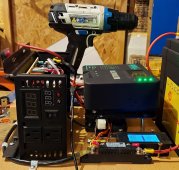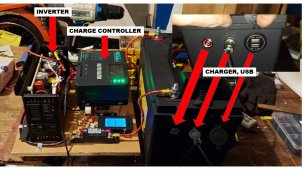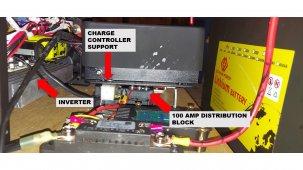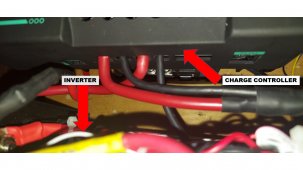oldmaninsaline
New Member
- Joined
- Oct 7, 2022
- Messages
- 68
A few months ago, I came to the decision that I'm getting too old to lug a 400 pound battery bank from our cabin and back home twice a year and decided to buy (to start with) a 100 AH lifepo4 battery. The lead acid based bank is 430 amp hours and in the spring and fall, I can only transport half of the bank and the 215 AH half-a-bank does fine overnight (since I usually use 30% of the capacity of the lead acid overnight when it's in the 215 AH configuration) so a single 100 AH lifepo4 seems like it will work.
And then I had the "brilliant" idea (because I like to do one bigly project every winter) that, you know what, those power station things are a pretty good idea. And way the heck too expensive - seriously, upwards of 2 grand for anything worthwhile watt hour wise? So off I went designing my own power station with the same features and displays as commercial versions. I'm also putting it in an appropriate case, a Seahorse SE920. Seahorse says they can punch out the openings that I need in the case - considering it.
The power station project has now gone from a breadboard setup to R&D mock-up. Currently, I am testing with a 600 watt inverter, a 100 amp fused distribution block (20 amps per circuit), a shunt monitor and a 20 amp charge controller. The entire electronics section fits in a 12 inch by 12 inch footprint and is less than 8 inches tall. This exercise is to build a quality power station with a 15 amp AC output, USB chargers, 12 volt outlets that costs less than $1,000.
This is using the Scream Power 100 amp hour battery (pouch design). I've replaced the 50 amp BMS with a Daly 100 amp BMS due to the original one failing during testing. Frankly, I didn't like it much anyways. The Daly BMS appears to be more efficient than the no name BMS it replaces.
When the project moves on to additional batteries and actually is installed in the case, I'll be replacing the Daly with a higher quality BMS with Bluetooth monitoring with a dedicated tablet attached to the power station case to monitor the batteries as well as the charge controller which is also Bluetooth. This way, I can monitor the solar input, the BMS data and also have the shunt display.
The charge controller is being tested using a laptop power supply (19 volts @ 7.25 amps) which the controller is quite happy with, churning out 6.5 amps. Thus when it is installed in the case, there will be an Anderson plug on the back that either the power supply or solar panels can be plugged into. I am also using the charger (concurrently) that came with the battery, 19 volts @ 7.25 amps) that will be wired after the shunt so that the shunt monitors both charger inputs - the one that came with the battery plugs into the side of the battery case so the shunt doesn't see it. So at this point, I have a 7.25 amp charger that came with the battery, another 7.25 amp laptop charger, the ability to use solar and as a sort of bonus, I have a Hitec X2 ACplus charger/balancer that I can use but that's going to involve bypassing the BMS in the battery.
As yet, I have not fused any of the sections of the device but will be adding ANL 100 amp fuses in the next few days. The inverter of course has it's own protection built in. I have considered using circuit breakers, however, the size of the components is a consideration. Another consideration is increasing the size of the cables when I start using a 1500 watt inverter. There is enough room in the design that I'm working with to accommodate 0 or 00 cables.






And then I had the "brilliant" idea (because I like to do one bigly project every winter) that, you know what, those power station things are a pretty good idea. And way the heck too expensive - seriously, upwards of 2 grand for anything worthwhile watt hour wise? So off I went designing my own power station with the same features and displays as commercial versions. I'm also putting it in an appropriate case, a Seahorse SE920. Seahorse says they can punch out the openings that I need in the case - considering it.
The power station project has now gone from a breadboard setup to R&D mock-up. Currently, I am testing with a 600 watt inverter, a 100 amp fused distribution block (20 amps per circuit), a shunt monitor and a 20 amp charge controller. The entire electronics section fits in a 12 inch by 12 inch footprint and is less than 8 inches tall. This exercise is to build a quality power station with a 15 amp AC output, USB chargers, 12 volt outlets that costs less than $1,000.
This is using the Scream Power 100 amp hour battery (pouch design). I've replaced the 50 amp BMS with a Daly 100 amp BMS due to the original one failing during testing. Frankly, I didn't like it much anyways. The Daly BMS appears to be more efficient than the no name BMS it replaces.
When the project moves on to additional batteries and actually is installed in the case, I'll be replacing the Daly with a higher quality BMS with Bluetooth monitoring with a dedicated tablet attached to the power station case to monitor the batteries as well as the charge controller which is also Bluetooth. This way, I can monitor the solar input, the BMS data and also have the shunt display.
The charge controller is being tested using a laptop power supply (19 volts @ 7.25 amps) which the controller is quite happy with, churning out 6.5 amps. Thus when it is installed in the case, there will be an Anderson plug on the back that either the power supply or solar panels can be plugged into. I am also using the charger (concurrently) that came with the battery, 19 volts @ 7.25 amps) that will be wired after the shunt so that the shunt monitors both charger inputs - the one that came with the battery plugs into the side of the battery case so the shunt doesn't see it. So at this point, I have a 7.25 amp charger that came with the battery, another 7.25 amp laptop charger, the ability to use solar and as a sort of bonus, I have a Hitec X2 ACplus charger/balancer that I can use but that's going to involve bypassing the BMS in the battery.
As yet, I have not fused any of the sections of the device but will be adding ANL 100 amp fuses in the next few days. The inverter of course has it's own protection built in. I have considered using circuit breakers, however, the size of the components is a consideration. Another consideration is increasing the size of the cables when I start using a 1500 watt inverter. There is enough room in the design that I'm working with to accommodate 0 or 00 cables.






Last edited:


